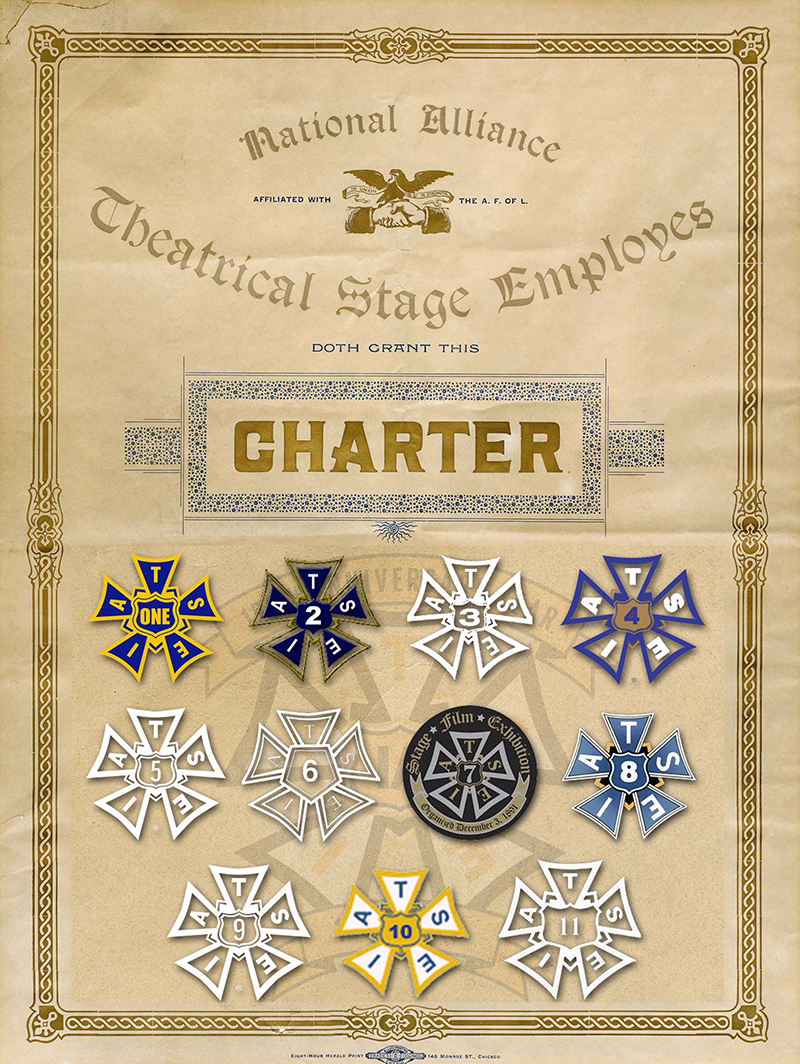
A Strong Legacy Continues
Still thriving, vital, and as relevant to every production, craft, and market segment of the entertainment industry, The International Alliance of Theatrical Stage Employees, Moving Picture Technicians, Artists and Allied Crafts of the United States, Its Territories and Canada, better known as I.A.T.S.E., this year is celebrating its 125th Anniversary, a milestone we at PLSN believed deserved to be taken note of and applauded.
In the IATSE Official Bulletin commemorating this anniversary, the International’s current President, Matthew D. Loeb wrote, “This year marks the 125th Anniversary of our great Alliance. Together we have persevered to build and sustain a union that serves and protects its members, and whose members have brought pride, dignity, and strength to each other. It is a time to reflect and give appreciation to those who came before us. The exhibition of bravery, commitment, and innovation brought us to where we are today.”
Looking back, it was with the same sense of receiving fair pay, safe working conditions, and the rights of workers to organize, no different than today, which inspired IATSE’s founders.
The Good Old Days?
In 1893 if you were an experienced stagehand you could take home 50 cents a day. Of course to get that you worked essentially non-stop, no meal breaks, through 100-hour weeks. Realizing that things needed to change and noting that the New York City stagehands had been successful in unionizing in 1886, 17 men from 10 cities — Boston, Brooklyn (yes, Brooklyn was its own city until 1898), Buffalo, Chicago, Cincinnati, Denver, Philadelphia, Pittsburgh, St. Louis, and Syracuse — traveled to join their NYC brothers as delegates at the first convention of the National Alliance of Theatrical Stage Employees on July 17, 1893. Certainly a bold move in 1893, however as noted, there was some foundation for them to stand upon with the history of the Theatrical Protective Union of New York.
It was actually 30 years previous, in 1863, that the first stage employees’ organization, Theatrical Workman’s Council started, which then became the Theatrical Mechanical Association in 1865. The Theatrical Mechanical Association had 41 members but it wasn’t a union until April 26, 1886 when the members met to draw up a new charter and a constitution establishing the Theatrical Protective Union of New York.
In 1888, the Theatrical Protective Union went on its first strike to demand a dollar a show and 50 cents for each load in and load out. When the use of strikebreakers resulted in a flat being dropped on renowned actor of the time, Louis James, during his Hamlet soliloquy, James demanded the union workers be brought back. He wouldn’t perform until they were back at work, and that solidarity between the stagehands and actors continues to this day. James’ and the unions’ demands were met.
Honoring this historic contribution to establishing the union, the delegates at the July 1893 meeting creating the Alliance designated the NY local, the Theatrical Protective Union Number One, which today is I.A.T.S.E. Local One.
Though John G. Williams of New York was selected as the first National Alliance president in 1893, his successor, Lee M. Hart, of Chicago, also had a significant impact on the Alliance in its early years. One of Hart’s defining moments was a speech at the third convention in 1895, when he stated: “Let the ties that bind us to the past, let the interests which demand our watchfulness of the present, let the nobility of our aspirations for justice, truth, liberty, and a grander development of our craft in the future, be the guiding stars to our actions.”
In 1896, the National Alliance reached the West Coast when the Los Angeles Theatrical Workers Union, which had independently formed in 1891, joined the Alliance. In 1898, the Alliance added two Canadian locals, making the union international. Both Canadian locals were full unions before joining the Alliance. Montreal’s Local 56 was organized in 1897, and Toronto’s Local 58 was organized in 1894. The National Alliance of Theatrical Stage Employees was renamed the International Alliance of Theatrical Stage Employees
(IATSE) in 1902.
Throughout the early years,
IATSE membership rose rapidly, from 1,500 in 1893 to 3,700 in 1900 and more than 21,000 members in 1920. While membership grew, members themselves faced challenges. During the Depression, estimates are that 10,000 of 16,000 members were out of work. Yet through the advent of television, films, tradeshows, and the resurgence of stage work, by IATSE’s 100th anniversary in 1993, membership had reached 74,000.
International president Thomas Short, who served from 1994 through 2008, focused on the idea of strength in numbers that a powerful union needs. Under his leadership IATSE went from 76,000 members to 111,000 during his tenure, a 46% increase. It should be noted this was when most other unions in North America saw a steady decline in membership. When Short retired, Matthew D. Loeb was elected the International president and stated, “I owe a huge debt of gratitude to Tom Short who made desperately needed institutional changes that will allow me to continue to build on a solid foundation. We are well positioned to meet the challenges of the future.”
Eye to the Future
Under President Loeb, education, outreach, and training have been a top priority, ensuring the relevance of the union to today’s industry and continuing the legacy of IATSE members being the highest skilled and best trained. IATSE has established the Labor Education Assistance Program (LEAP); partnered with Lynda.com; appointed the IATSE Craft Advance Program (ICAP) team; created the IATSE Entertainment and Exhibition Industries Training Trust Fund (IATSE-TTF). With a focus on the future, the IATSE Young Workers Committee was formed and the IATSE Student Outreach Program was created. Since 2015, the IATSE’s Women’s Committee (IWC) has strengthened the voice of women in the IA as well as reduced incidents of discrimination and harassment. In 2020, the first-ever IATSE Women’s Institute is scheduled.
Returning to President Loeb’s words to the membership on the 125th anniversary, “We must have vision to forge the path to the future with no less tenacity than those who laid the foundation upon which we have built the greatest union in the Labor Movement. There is no other product on the planet that rivals entertainment in requiring the coordination of so many technical and artistic workers to create. It is the great skill that IATSE members bring to the job, their cooperation and expertise that creates the products that dazzle and awe audiences around the globe. But it is the solidarity of the members and the fact that you care about each other that ultimately creates the strength for the union to provide the dignity and security you so richly deserve.”
You can read a detailed history of the IATSE at www.plsn.me/IATSE-125. The facts and quotes in this article were sourced from the IATSE Official Bulletin Number 660 and the history pages at www.iatse.net/timeline and www.plsn.me/LocalOne.


